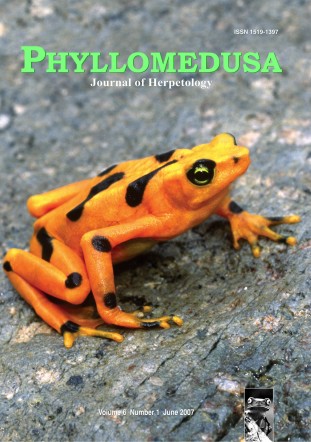Ecology of Alopoglossus angulatus and A. atriventris (Squamata, Gymnophthalmidae) in western Amazonia
DOI:
https://doi.org/10.11606/issn.2316-9079.v6i1p11-21Keywords:
Squamata, Gymnophthalmidae, Alopoglossus, microteiid, lizard ecology, AmazôniaAbstract
We studied the ecology of Alopoglossus angulatus and A. atriventris in western Amazonia. Both species are found in leaf litter of lowland tropical forest, but A. angulatus tends to be found near water whereas A. atriventris is found in terra firme forest. Both tend to be active in shade on sunny and cloudy days. Body size of adults differs (A. angulatus larger), but species differences in sizeadjusted morphology are minor. Sexual dimorphism exists in relative head length (males larger) only in A. atriventris. Diets are similar, with roaches, spiders, grasshoppers/crickets, and springtails dominating the diet. Overall, these lizards are similar ecologically even though they occur together at many sites. Leaf litter and shaded forest appear to be requisites for survival at the local level.Downloads
Download data is not yet available.
Downloads
Published
2007-06-01
Issue
Section
Articles
License
All material originally published in Phyllomedusa belongs to Escola Superior de Agricultura Luiz de Queiroz - Universidade de São Paulo. All contents are under a license of Creative Commons BY-NC-ND.How to Cite
Vitt, L. J., Ávila-Pires, T. C. S., Espósito, M. C., Sartorius, S. S., & Zani, P. A. (2007). Ecology of Alopoglossus angulatus and A. atriventris (Squamata, Gymnophthalmidae) in western Amazonia. Phyllomedusa: Journal of Herpetology, 6(1), 11-21. https://doi.org/10.11606/issn.2316-9079.v6i1p11-21



 Impact Factor (JCR): 0.600
Impact Factor (JCR): 0.600 CiteScore: 1.0
CiteScore: 1.0